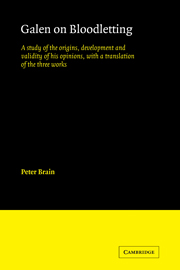 Galen on Bloodletting
Galen on Bloodletting Book contents
- Frontmatter
- Contents
- Preface
- Note on abbreviations and references
- Note on manuscripts and editions
- 1 Galen and his system: an introduction
- 2 Galen's Book on Venesection against Erasistratus (translation)
- 3 Galen's Book on Venesection against the Erasistrateans in Rome (translation)
- 4 Galen's Book on Treatment by Venesection (translation)
- 5 Development of Galen's views and methods as shown in the three works
- 6 Galen, venesection and the Hippocratic Corpus
- 7 Galen's practice of venesection
- 8 Galen's revulsive treatment and vascular anatomy
- 9 The testimony of other writers and the validity of Galen's opinions on sites for venesection
- 10 Galen's use of venesection as an evacuant: can it be justified? A medical digression
- 11 Conclusion
- Glossary
- Works cited
- Index
3 - Galen's Book on Venesection against the Erasistrateans in Rome (translation)
Published online by Cambridge University Press: 04 August 2010
- Frontmatter
- Contents
- Preface
- Note on abbreviations and references
- Note on manuscripts and editions
- 1 Galen and his system: an introduction
- 2 Galen's Book on Venesection against Erasistratus (translation)
- 3 Galen's Book on Venesection against the Erasistrateans in Rome (translation)
- 4 Galen's Book on Treatment by Venesection (translation)
- 5 Development of Galen's views and methods as shown in the three works
- 6 Galen, venesection and the Hippocratic Corpus
- 7 Galen's practice of venesection
- 8 Galen's revulsive treatment and vascular anatomy
- 9 The testimony of other writers and the validity of Galen's opinions on sites for venesection
- 10 Galen's use of venesection as an evacuant: can it be justified? A medical digression
- 11 Conclusion
- Glossary
- Works cited
- Index
Summary
In this second book Galen explains the circumstances in which the first work was written and its effects on medicine in Rome when its contents were made public.
When I first came to Rome I found certain physicians who avoided phlebotomy so sedulously that sometimes even when a person was suffocating from plethos they refused to use the remedy. In the case of a woman almost twenty-one years old, who had a red face and a slight cough and already some difficulty in breathing, as a result of suppression of the menstrual catharsis, I found them lightly binding her limbs with woollen bandages and ordering her to fast, but neither using phlebotomy themselves nor permitting me to do so. Since they were more trusted than I was because of their intimacy with the woman's family and their seniority, I gave up for the time being the attempt to convince them concerning phlebotomy; I did, however, enquire whether there would be any objection to provoking a flow of blood to the uterus by means of drugs with the power to effect this. When they agreed, I at once sought out the patient's usual midwife and urged her to make use of them. She told me, however, that she had used them as the occasion demanded, when the monthly purgation was expected to occur, and mentioned the drugs she had applied to the woman; they were all of approved quality, so that no one could think the treatment had failed because of their weakness.
- Type
- Chapter
- Information
- Galen on BloodlettingA Study of the Origins, Development and Validity of his Opinions, with a Translation of the Three Works, pp. 38 - 66Publisher: Cambridge University PressPrint publication year: 1986


